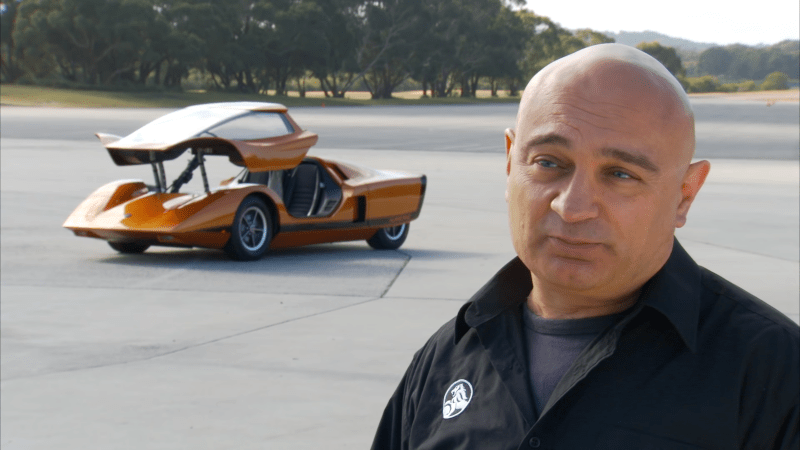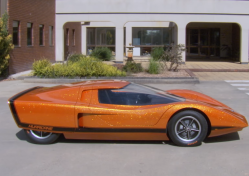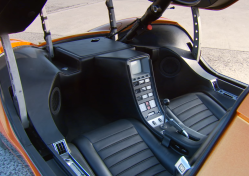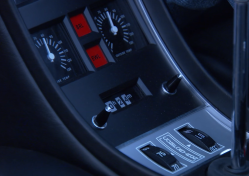If your friend told you their car had a backup camera, a digital dashboard, climate control, could scan for radio stations, and even helped stay on the road, you wouldn’t think much about it. Unless the year was 1969. The car — the Hurricane by Australian automaker Holden — was never a production vehicle. But it was way beyond the state of the art in 1969 and isn’t too dated, even today. The concept car was actually found in 1988 and restored by 2011. Honestly, it still looks great.
The car looks amazing and was meant to be a research vehicle and — probably — nice eye candy for the car shows. Seating two passengers with a mid-mounted 253 cubic inch V8, it featured many things we take for granted now: a backup camera, temperature control, and a (somewhat) digital dashboard, for example. There was a system to help it stay in lane, but that required magnets in the road — it was 1969, after all.
The fiberglass body was unique and had a canopy instead of doors. The power seats lifted up when the canopy came up and went down for driving. The passenger compartment was a steel cage. The vehicle featured headrests, a foam-lined fuel tank, and a fire warning system. Two of the brakes were even oil-cooled.
Sure, the car is undeniably cool, but it also reminds us that it is important to reach beyond the possible. We imagine that if you tried to build something this far ahead of our current tech today, you’d have to be prepared to finance it yourself. The car probably didn’t do anything financially for Holden in the near term. But look at how much foresight the designers of this car had! Granted, some things just were’t ready yet. The digital clock with the dials is probably not going to last long on bumpy roads. Magnets on the road have their own problems and were doubtlessly impractical. But the ideas are solid and you imagine influenced future designers.
So what are we doing today that is just beyond our reach but will inspire the future? Are we just adding more CPUs and more memory to existing things? Some extra buttons on our mouse? Are we adding one more feature to our programming language of choice? Where are the truly innovative programming languages, CPU architectures, and I/O devices coming from? It is hard to imagine 50 years from now someone remembering a great deal of what we build today and considering it revolutionary.
Meanwhile, who’s up for building a replicate Hurricane? It isn’t as ridiculous as it sounds. Not that it isn’t a major undertaking, but it would probably be easier with today’s technology to match some of what the Hurricane was doing before we’d even landed on the moon.



















Imagine getting in and out when it‘s raining ;)
water sports
You don’t use this car when it rains but the rolls-royce…
Nah, forget the Rolls – you have to get out of it before you can pull the (included) umbrella out of the door. Whose bone-headed idea was that?
“The Help” pulls the umbrella out of their door and opens it before they open your door.
Some people just have no class.
Rolls are driven by a multi-function “agent” who also opens the door for you and holds the umbrella. They are not meant to be driven by the customers.
All those innovations, and yet the steering wheel is on the wrong side!
B^)
They accidentally made all the dials with imperial measurements too! Not very futuristic, given that was about the time Australia went metric.
No accident, imperial got men on the moon in ’69.
May I suggest you do a little research on what units were used for calculations inside the Apollo Guidance Computer, and then maybe rethink your comment ;-)
Well, one is easily confused by the fact that internal calculations used metric/SI and the DSKY displayed it in imperial units not to confuse the pilots…
It probably has more to do with target demographics than anything else. The sort of person who might like a car like this might be turned off by the “newfangled” metric system. Same with NASA – they might use metric measurements exclusively in house, but when writing press releases, it was all pounds and miles.
Australia did not switch to metric until 1971
https://en.wikipedia.org/wiki/Metrication_in_Australia
And it made a mars orbiter a mars lander in 1990. So ingenious!
German scientists put the men on the moon using metric.
To quote Mrs Archer:
https://youtu.be/d91bVlavt24
And then they didn’t correct the mistake on the restore :) . Neat looking car though. A head turner for sure.
Looks like it’s on the right side.
touche’
“253 cubic inch V8” Sigh, my Controlling Member went limp at the sight of that…
Honestly wondering which way you are going with this. Mid engine small block V8 is a winning recipe, so wondering if you are sad it isn’t a big block, or if you have problems with V8’s and wish it was like a Porsche Boxer engine, or what? Also though +1 for use of term “controlling member”
@craig asked: “…so wondering if you are sad it isn’t a big block, or if you have problems with V8’s and wish it was like a Porsche Boxer engine, or what?”
Happy to clarify. I used to bracket race a highly optimized `69 440 Plymouth Roadrunner. It ate small block chevys for lunch.
Lots of folks have cars that would eat your 440 for lunch too, what’s your point?
“Lots of folks have cars that would eat your 440 for lunch too, what’s your point?”
Point is I was answering Craig’s question – I prefer Big Blocks. Many years ago when I was running that 440 Roadrunner, in its class it was tough to consistently beat. JohnU, you know ZERO about how that car was built. So I’ll just ignore your post now.
Drone: To be fair…’Bracket’ all about consistency, not speed. Brackets are consistently owned by wily old farts that win by finishing second.
I’ve got a 383 HD Saratoga now (pre 440 debored 440). Tank, snail, 4 wheel drum brakes. Turns heads like Italian trash though. Appreciates every year.
@craig asked: “…so wondering if you are sad it isn’t a big block, or if you have problems with V8’s and wish it was like a Porsche Boxer engine, or what?”
Happy to clarify. I used to bracket race a highly optimised `69 440 Plymouth Roadrunner. It ate small block chevys for lunch.
That car could sell today with technology upgrades.
It would sell just fine without them. The reason our cars are all soulless today is the technology upgrades
General Motors did make a vehicle based on this car, it was called the Fiero and it was a disaster.
General Motors had a Highway of the Future at the1964 New York World’s Fair
Did it inspire the song, “Highway to Hell”?
B^)
That’s because GM didn’t allow the engineers to build the car the way they wanted until the final model year. If you are considering buying a Fiero, that is the one to get.
not to mention, the Fiero wasn’t a disaster, I understand that the final production year was still making money, but the corvette people were upset that something other than the corvette was selling in low numbers that only the corvette was allowed to maintain and not be canceled.
The engine fire issue got worse and worse every year, the last model year had the worst fire problem. The estimate is that 10% of the cars from that year caught fire.
Would be interested in knowing more about this. My friend’s dad had a Fiero GT that was an absolutely awesome car- affordable, low, plenty of power, handled like it was on rails on twisty roads and, if I remember, had a T-top or removable hard top. Was it mis-marketed or did it have some fatal mechanical flaws? I don’t know much about the car other than it was fun as hell to borrow when we were 16-17 and dad was out of town.
Back in my younger days (when i had hair and 30lbs lighter) I worked with a guy who had a Fiero on the night shift.
We would occasionally go out for breakfast afterwords .
We squeezed 3 people into that 2 seater ….. one being a guy that was 300lbs and me wedged in behind what little room was left lol
It had serious fire issues, poor reliability all around, terrible gas mileage for a two seater, no cargo space, bad brakes, poor sales, very bad crash test results, etc.
The Fiero used bits and pieces from the front wheel drive J platform. For 1988, Pontiac was finally allowed to put in all the good bits they’d developed before being forced to use things like the stock J platform bushings and other non-performance parts. The 4 cylinder engines (across the J platform line) suffered from reliability issues for a time, some say due to deliberately shoddy work done by union workers during a labor dispute. The Fiero 2M4 had some issues with coolant leaks that caused fires.
Since the 1988 Fiero got all the good stuff, GM parts did a good business with orders from owners of 1984-1987’s buying the upgraded suspension parts.
Buick Skyhawk, Chevrolet Cavalier (also Z24 V6 3 door and convertible, Mexico also got a Z24 coupe but not the convertible), Oldsmobile Firenza, Pontiac J2000 and Sunbird (a convertible), Cadillac Cimarron.
The Z24 and Cimarron could be had with a 2.8L V6, though for some reason accessory parts, including intake manifolds, were so different between the two they weren’t interchangeable. IIRC the Z24 used a right side air inlet while the Cimarron used a left side inlet. I know the radiator tanks were different because when I had a Cimarron and needed a right side tank replaced, the shop said it’d take up to a week then they called the next day and said it was done. Turned out that 10 years prior they’d repaired a Z24 radiator and ordered a Cimarron tank by mistake. It sat on a shelf for a decade and the owner remembered he had it.
Outside the USA it was the Chevrolet Monza (Brazil), Holden Camira, Isuzu Aska (South America and briefly the Holden JJ Camira in New Zealand), Opel Ascona C, Vauxhall Cavalier Mark 2.
For 1995 the J platform was changed to a blobby shaped platform with Isuzu drivetrains, though still claimed to be of the same lineage. In the USA only the Cavalier and the Sunbird (renamed Sunfire as a 2 door, 4 door, and convertible) went to the new platform. Outside the USA they were all gone except the Monza went into 1996 on the old platform and Toyota imported right hand drive Cavaliers. This Cavalier would continue through 2005.
I think it may have been mis-marketed, as there were already two almost identical cars out there, the Toyota MR2 and the Fiat X1/9. The Fiero did have one mechanical flaw, which was insufficient cooling due to not enough natural airflow over the engine, a problem it shared with the X1/9. Either of them would catch fire if you let them get low on coolant or oil. I had an ’87, and LOVED it. Even with the 2.5L inline-4, it had plenty of power, but the main draw was its low center of gravity, which along with a nice stiff suspension glued it to the road. Only car I’ve ever owned that I could drift.
No. Death trap in a rollover accident. Would never be street legal.
‘Billionaire doors’ (waves arms over head) are just dumb. Same goes for Tesla door handles.
I was really tempeted in 1981 to build one of these kits. You used a VW Beetle as a donor car.
https://dailyturismo.com/some-assy-required-1978-sebring-kit-car/
https://barnfinds.com/cheap-exotic-1980-bremen-sebring/
In 2022 you could make the backup camera a FLIR when driving in fog.
I also liked where they placed the AM/FM radio.
Driving backwards in fog…
I get Lepidoptera in my thorax considering that possibility.
I’m curious to know if there’s any relation to the Sterling Nova kit car.
“You used a VW Beetle as a donor car.”
Hey, you know how HaD commenters feel about gutting old time equipment!
B^)
LOL, I love the lack of editing here (on a technology website, of all places).
I was thinking of a forward camera for driving, using the came display.
By the way, in the early 80’s I had a X1/9 (and a Yamaha TX500). Now it’s a 2012 Civic.
You had an X1/9 and a TX500, and now they have become a 2012 Civic? Sounds like a subject for either a great Hackaday article or a multi-year YouTube series.
Using a donor Beetle was kind of common for things like dune buggies, old timey car kits and so on. My dad and I always wanted to build a woody wagon, had the plans and stuff but never got around to it. Haven’t looked at how much a donor car would be today but 20 years ago they were peanuts, before they became (kinda) collector cars.
It looks very plane jane AM only no EQ or anything but those 5″ speakers and the 8 track on the left. No cassette!
“could find radio stations”
Several decades ago, I helped with the restoration a 1958 Cadillac. That’s when I first became aware of the “WonderBar” radio which had automatic station seeking functionality. Really big car, really cool radio. (Pretty sure that I’ve owned cars that were smaller than the passenger compartment of that thing.)
Back in high school, a friend showed me his 1953 car (old by that time) which had a station seeker button under the driver’s floor mat. Way cool!
In 1971, Elementary Electronics had an article about a guy in the UK who’d modded his car so he could start it by talking into a walkie talkie. And he added sensors so the windshield wipers started when it rained. Not the same thing, but at the time it seemed neat. No computers involved, no 555s either
All that foresight and they put the steering wheel on the wrong side.
The steering wheel lock ignition is on the left side of the steering post too. Right handed friendly? I used to drive US postal jeeps and the ignition key was on the flat vertical dashboard near the middle of the dash. I remember reaching across under the steering wheel with my right hand sourced keys and starting it. Shifting the automatic was a sinister affair. I guess a lot of the world has to shift this way.
For skills that don’t require much finger dexterity, there isn’t much difference between left-handed and right-handed. I will remind you that motorcycles put the clutch – the most demanding hand control, I think – in the left hand, and nobody has a problem with that.
the clutch being on the LHS is a hold over from hand signals
Looks difficult to get the corpses out after an accident.
Out? Leave ’em in and bury the whole thing.
loved that car in deathrace 2000
C
O
M
F
O
R
T
R
O
N
Must be a language thing, i thought the backup camera was for when the main camera failed, but after reading CRT backup camera…
1:37 look at that! A 6 lamp navigation system!
Brilliant in simplicity
I saw this car several months ago. It is currently on display at the National Motor Museum just outside of Adelaide, South Australia. They also have a 1971 Torana GTR-X concept which is equally as retro-cool as the Hurricane.
https://motor.history.sa.gov.au/events/holden-heroes-a-retrospective-1948-2017/
For those that don’t know, Holden closed its factories in 2017 and I’m told that GM is going to retire the Holden badge, so I assume that Australia and New Zealand will get the GM products of North America or Europe.
I saw this car when I was 7, on display somewhere like Myer
we were on a school excursion
All the future petrol heads were in awe, some of us even drooled a bit!
In the same building was the Bat-mobile from the TV series and the Lost In Space Chariot!!
Best day eva!!
have a look @ this concept car from ’68…
nice design, no imperial funny things and the steering wheel at the proper side… 🤣👍🏻
https://dyler.com/posts/23/alfa-romeo-carabo-the-scissor-door-s-inventor-from-italy
Jack